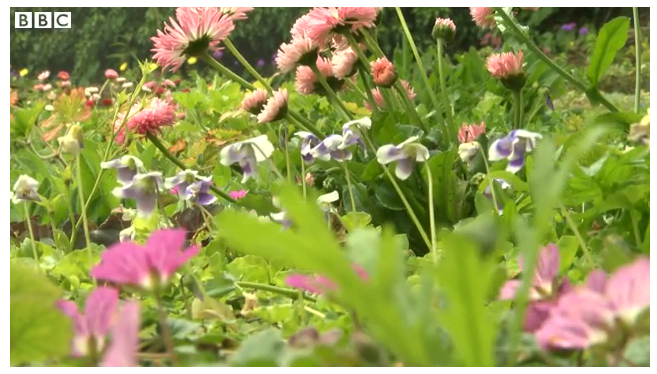Landscape Architecture for Landscape Architects › Forums › STORY BOARD › Flowers replace grass in UK
- This topic has 1 reply, 5 voices, and was last updated 10 years, 10 months ago by
 Trace One.
Trace One.
-
AuthorPosts
-
June 12, 2013 at 10:07 am #154856June 12, 2013 at 3:23 pm #154870
 Trace OneParticipant
Trace OneParticipantvery funny, Henry.
On the other hand, I think even Benjamin Franklin knew we cannot have a world without bees..
: )
June 12, 2013 at 4:27 pm #154869 Rob HalpernParticipant
Rob HalpernParticipantThis will require the same locality based research as the best green roof technology has. While the idea of thyme lawns and chamomile lawns is old, that won’t work everywhere.
Here are some interesting links to this project:
http://blogs.reading.ac.uk/grass-free-lawns/files/2013/02/Grass-Free-Lawns.pdf
June 12, 2013 at 4:42 pm #154868 Roland BeinertParticipant
Roland BeinertParticipantI’ve been experimenting with some varieties of thyme and a few other walkable ground covers in the small garden behind my apartment. The first year they didn’t grow much, but most of them really took off the second year. The wooly thyme is probably the best of them. It tolerates moderate foot traffic and feels nice on bare feet. The elfin thyme looks good, but seems to grow slower than the others. Creeping thyme flowers more and spreads well, but it tends to form mounds rather than spreading evenly.
Also tried scotch moss and chamomile. The scotch moss grew well and looks nice, but I learned it gives off some sort of chemical that can irritate skin or cause an allergic reaction. I had no reaction to it, but its not one I’d recommend to clients to walk on. The chamomile was very sensitive and turned yellow if it was stepped on.
Anyone else played around with this sort of plant in their garden, and, if so, what did you find?
June 12, 2013 at 8:45 pm #154867Tanya Olson
ParticipantHow many volunteers does it take to weed the grass out of a grass-free lawn? haha!
June 12, 2013 at 9:02 pm #154866 Roland BeinertParticipant
Roland BeinertParticipantGood point. That’s why you sheet mulch over any existing grass lawn first.
June 12, 2013 at 9:17 pm #154865Tanya Olson
ParticipantI don’t know about your grass, but our grass doesn’t take no for an answer!
Except for where we DO want it to grow, then its the most finicky plant in the world.
June 12, 2013 at 10:46 pm #154864 Roland BeinertParticipant
Roland BeinertParticipantGrass is tough, but sheet mulching has a good track record against it. Starve the grass of irrigation for a while, then cover it with a layer of cardboard or newspaper (cardboard works better). Then cover the cardboard with several inches of mulch.
I did this when I started my garden. There were a few blades of grass that would poke up between the sheets of cardboard for a while, but nothing I couldn’t handle on my own. I probably could have overlapped the sheets better and avoided that. After the first year, that stopped. Sheet mulching also improves the soil a lot.
June 13, 2013 at 10:24 am #154863 Trace OneParticipant
Trace OneParticipantIsn’t Nebraska synonymous with ‘grasslands’, wheat fields, etc. Never been there, but that is my image..Grass in the CA. central valley is only there if it is irrigated – in fact, lawns are NOT for sitting, here, unless you want the wet posterior look for the rest of the day..hee hee.
June 13, 2013 at 11:00 am #154862 Trace OneParticipant
Trace OneParticipantoops, I am confusing Nebraska with South Dakota, I think, Tanya. Your South Dakota grass is even healthier than Nebraska grass..from what I hear…
June 13, 2013 at 4:51 pm #154861Tanya Olson
ParticipantIts definitely tenacious!
June 27, 2013 at 10:01 pm #154860 Richard KidgerParticipant
Richard KidgerParticipantHi everyone,
I found your link to this BBC page on grass free lawns, it’s very interesting and currently Sheffield University has done similar types of planting strategies. I love the increase biodiversity within garden; my bird boxes are regularly full of Tree Bees every year.
The project is more of a sensory garden area than a lawn; which is nice but I feel that it wouldn’t last without constant maintenance. I would love to see a project with tough and robust forms of planting plan for this project. But to be truthful I have a garden full of creeping buttercups, daisies and wild plants that do the job fine.
One event in the UK, grass verges on Motorways (Freeways) has been left to grow wild with one cut in winter. This method has saved millions on budgets every year and has been very beneficial to the biodiversity.July 1, 2013 at 5:34 pm #154859 Rob HalpernParticipant
Rob HalpernParticipantThis recent article from American Nurseryman explores a similar approach:
July 1, 2013 at 7:58 pm #154858 Richard KidgerParticipant
Richard KidgerParticipantHi;
It is good that American Nursery Journal is following the same line, I have seen some impressive designs with the freeway bridges incorporating large areas for animals and over species to make safe passage. This also helps bio-diversity in vast amounts. I look forward to reading the link,
Thank you so much Richard Kidger
July 1, 2013 at 8:10 pm #154857 Richard KidgerParticipant
Richard KidgerParticipantimpressive article, I like the species listing.
regards Richard
-
AuthorPosts
- You must be logged in to reply to this topic.


